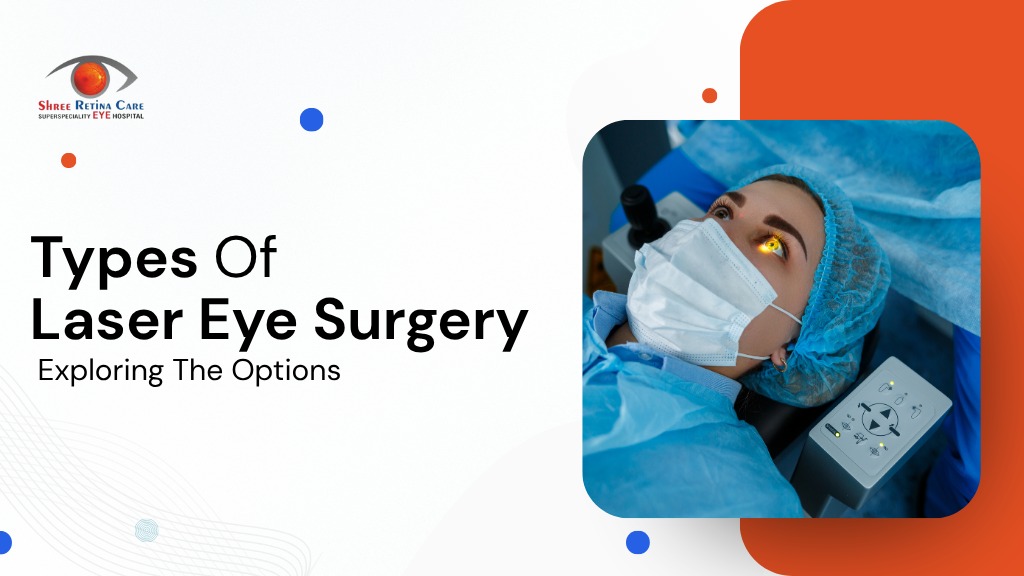Types Of Laser Eye Surgery: Exploring The Options
A lot of people go for laser eye surgery because they want to get rid of the habit of wearing specs or dealing with contact lenses every day. It’s helped many get back to a clear vision without needing anything extra.
What most people don’t always know is—there’s not just one kind of laser treatment. There are number of types and each one has its own specialty. This blog breaks them down in a simple way—what they are, how they work, and who they might be right for—so you can figure out what suits your eyes best.
How Does Laser Eye Surgery Work?
Laser eye surgery reshapes the curve of the cornea—the transparent colored looking layer of the eye—so that images can form in the right way at the back of the eye, where they’re meant to.
The vision gets improved when the shape of the cornea is corrected. For different types of eye surgery, doctors use specific lasers—like excimer or femtosecond—to reshape the eye so that vision improves.
Types Of Laser Surgery: Detailed Comparison
| Surgery Type | Method | Recovery | Suitable For |
| LASIK | Corneal flap + excimer laser | 1–2 days | Mild to moderate vision issues |
| PRK | Surface reshaping | 5–7 days | Thin corneas, an active lifestyle |
| LASEK | Similar to PRK with alcohol-assisted technique | 7–10 days | Mild vision errors, thinner corneas |
| SMILE | Small incision, no flap | 2–3 days | High myopia, dry eyes |
| Contoura Vision | Topography-guided LASIK | 1–2 days | Irregular corneas, night vision problems |
1. LASIK
LASIK is what most of us know, as it is very common, and most people go through this wishing to get rid of their glasses permanently. The most common and widely accepted type of laser eye surgery. A thin layer on the surface of the eye is moved aside, and the laser changes the tissue in the thin layer, which improves clarity. The flap is then placed back, and healing begins.
Also read: Is LASIK Eye Surgery Painful? Does LASIK Hurt, and Is It Safe in the Long Run?
Why people choose LASIK:
- Quick recovery
- Minimal discomfort
- Suitable for most vision errors
2. PRK
In PRK, no flap is created. Instead, the outer layer of the cornea is removed, and the laser is used directly on the surface. The eye takes a few extra days to heal but may be a better option for people with thinner corneas.
Best for:
- People involved in contact sports
- Those with thinner corneas
3. LASEK
LASEK is similar to PRK, but the surface layer is lifted with alcohol and then replaced after the laser is used. It causes less discomfort than PRK and is an option for people not eligible for LASIK.
4. SMILE
SMILE is a newer, flapless surgery. A small piece of tissue is taken out from within the cornea using a femtosecond laser. No flap means fewer complications and faster healing.
Good for:
- Nearsightedness problem
- People with dry eyes
5. Contoura Vision
Contoura Vision is a newer form of LASIK that uses close-up view of the cornea for more accurate treatment. It helps reduce issues like halos or glare at night and improves overall visual quality.
Who Is A Perfect Fit For Laser Eye Surgery?
Laser eye surgery is suitable for adults over 18 with a stable eye prescription for at least a year. Your cornea should be healthy, and your eyes free from infections or major issues like keratoconus.
It may not be right if you:
- Are you pregnant or breastfeeding
- Have very dry eyes
- Have unstable vision or chronic eye diseases
Benefits And Risks To Keep In Mind
Benefits:
- Clearer vision without glasses
- Painless procedure
- Fast recovery (especially with LASIK or SMILE)
Risks:
- Temporary dry eyes
- Light sensitivity or halos
- Rare need for touch-up surgery
What Comes Before, During & After
Before:
- Eye tests to check cornea thickness, vision stability, and dryness
During:
- Painless, 15–20 minute outpatient procedure
- No injections or stitches
After:
- Blurry vision for a few hours
- Use eye drops and avoid rubbing your eyes
- Back to normal in 1–7 days, depending on the type
How To Choose From Various Types Of Laser Surgery
There’s that single treatment method that fits everyone. It depends on
- Your eye power and cornea condition
- Lifestyle (sports, screen time)
- Recovery preference
- Doctor’s recommendation
Talk to a trusted eye specialist in your city to understand what suits you best.
Conclusion
Laser eye surgery isn’t just one single treatment. From LASIK to SMILE, every option has its place. What really makes the difference is selecting what works best for your eyes and its functionality.
If you’re thinking about getting rid of glasses or contacts, take the first step: consult a good eye doctor near you and explore your options.

